In an age where the majority of presbyopic patients who require a distance prescription choose progressive power lenses, it is easy to consider segmented lenses, namely bifocals and trifocals, or separate single vision spectacles as relics of a bygone age. Yet, there remains a large number of patients who prefer them or have no choice but to wear them.
Additionally, manufacturers continue to innovate in this field. High index photochromic bifocals were launched only recently in 2020, and a host of independent labs are also making further advances in bifocal lens designs. Free form digital surfacing technology is being used to resurrect lens designs that have been discontinued for many years, and new designs are being developed such as blended/invisible segment bifocals including round segments as large as 110mm and blended slab-off/reverse slab-on lenses.
Single Vision Lenses
The use of ready readers by emmetropic presbyopes was covered in the previous article, however prescription single vision reading spectacles, and two separate pairs of spectacles where distance correction is also required remain common means of correcting presbyopia. Single vision correction is also popular for intermediate use thanks to the archaic Display Screen Equipment regulations that specify employers only contribute to the cost of spectacles if they are specifically for use on a computer and their simultaneous reluctance to contribute to the cost of potentially more ideal options such as degressive lenses (enhanced readers), occupational progressives, or bifocals set up for intermediate and near working distances.
Advantages of single vision correction
The advantages of single vision go hand in hand with the disadvantages. In the previous article (see Optician 19.11.21), we covered the working distance range available through single vision spectacle: the far point is the reciprocal of the add and so is infinity when the add is zero for distance. The near point is the reciprocal of the combined add and amplitude of accommodation, and the comfortable near point the reciprocal of half to two-thirds of the available accommodation when combined with the addition. The advantage of single vision spectacles is a full field of view for a given range of working distance. Conversely, the downside is a reduced range of vision compared to multifocals that becomes increasingly problematic as presbyopia advances and the amplitude of accommodation reduces. Nevertheless, providing all points of the task, such as a personal computer monitor, are within the range of comfortable vision, single vision spectacles remain an excellent alternative and before recommending alternatives opticians should be sure that they will really find them beneficial for the task at hand (figure 1).
 Figure 1: Single vision spectacles remain an excellent solution for computer use
Figure 1: Single vision spectacles remain an excellent solution for computer use
Centration of single vision spectacles
Another advantage of separate pairs of spectacles is the ability to centre the lenses differently, particularly in the vertical meridian, and most importantly when the patient is anisometropic and has a significant difference in powers between the two eyes. Both distance and reading spectacles should be centred so that the centre of rotation condition is satisfied in order to avoid unwanted oblique astigmatism being induced. In other words, the optical axis of each lens should pass through the centre of rotation of the respective eye.
Horizontally the bow of the frame (dihedral, face-form or wrap angle) should reflect the orientation of the visual axes (figure 2). For distance spectacles the eyes should be parallel in the primary position so the frame should have a dihedral angle of zero. For near vision spectacles the dihedral angle should be negative, (an anhedral angle) to match the converged visual axes and is relative to the working distance and vertex distance of the frame. The operative word here is should, and spectacle frames are often not aligned for the prescription to perform optimally – most frames have some degree of wrap, 5-10 degrees is typical. A good tip when patients complain their glasses ‘just don’t feel right’ is to adjust the bow of the frame to match the lenses. Where this is not possible, especially on sports frames, but also on many others, then personalised single vision lenses should be ordered where a cylindrical component is incorporated in the lens to negate the oblique astigmatism caused by inappropriate wrap.
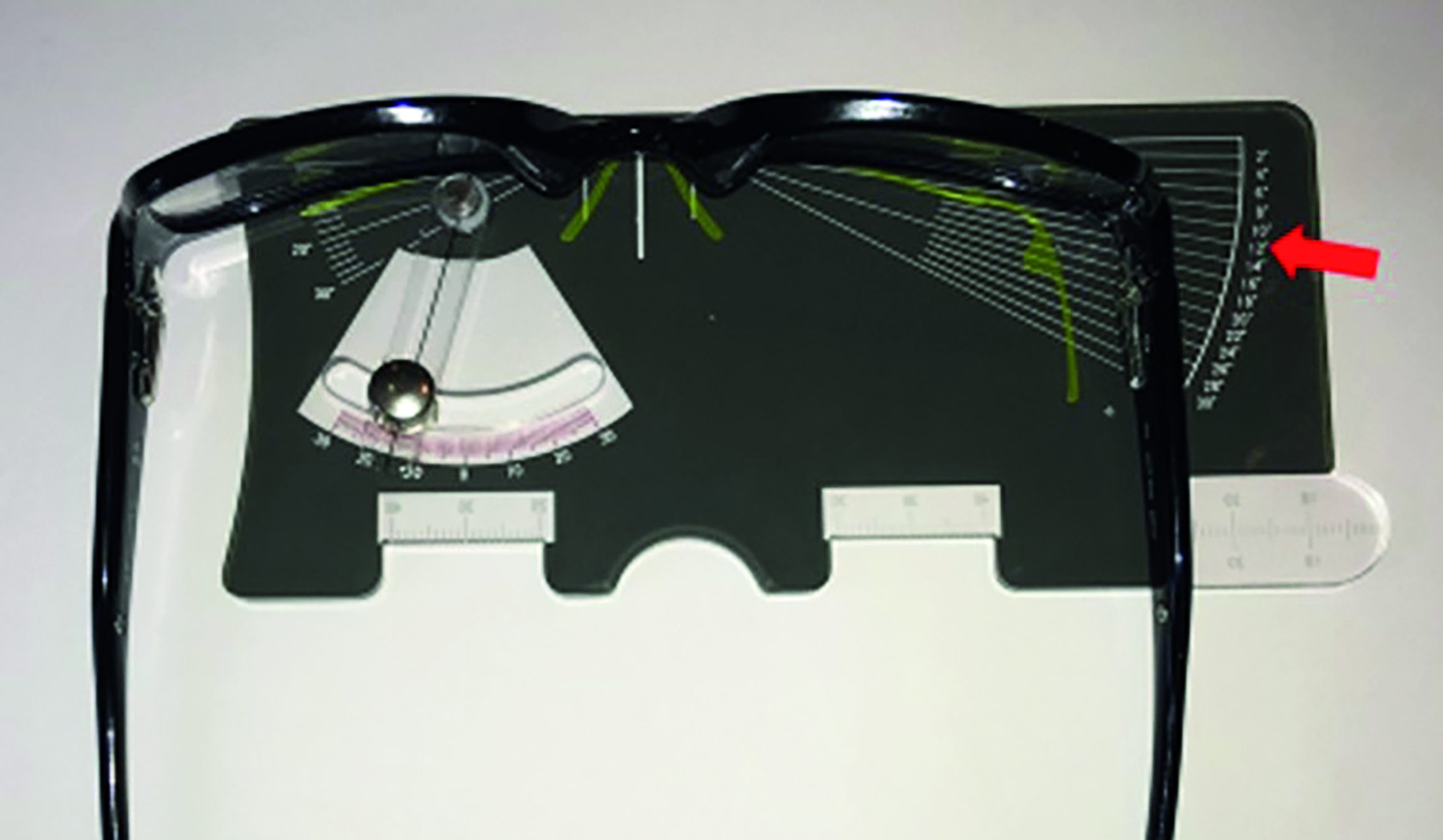 Figure 2: Measuring the dihedral angle
Figure 2: Measuring the dihedral angle
In the vertical meridian, oblique astigmatic error can be avoided by measuring pantoscopic tilt (figure 3) and heights to pupil centre, and dropping the optical centres 1mm for every 2 degrees of tilt. This applies as much to near and intermediate lenses as it does to distance spectacles in any given frame,1 so where lower optical centres are required, for example in order to alleviate differential prismatic effect at near, then a frame with a large pantoscopic tilt should be selected. This is typically the case with frames designed solely for near vision use, such as half eyes (figure 4). Similarly, in anisometropic patients it may be best to centre the distance lenses on pupil centre in order to alleviate the differential prismatic effect that might occur if the optical centres were placed on horizontal centre line (HCL) at the lower limbus as is usual. When optical centres are required to be on pupil centre then a frame with a pantoscopic tilt of zero is required and can easily be achieved with small oval or round eye frames with a central joint.
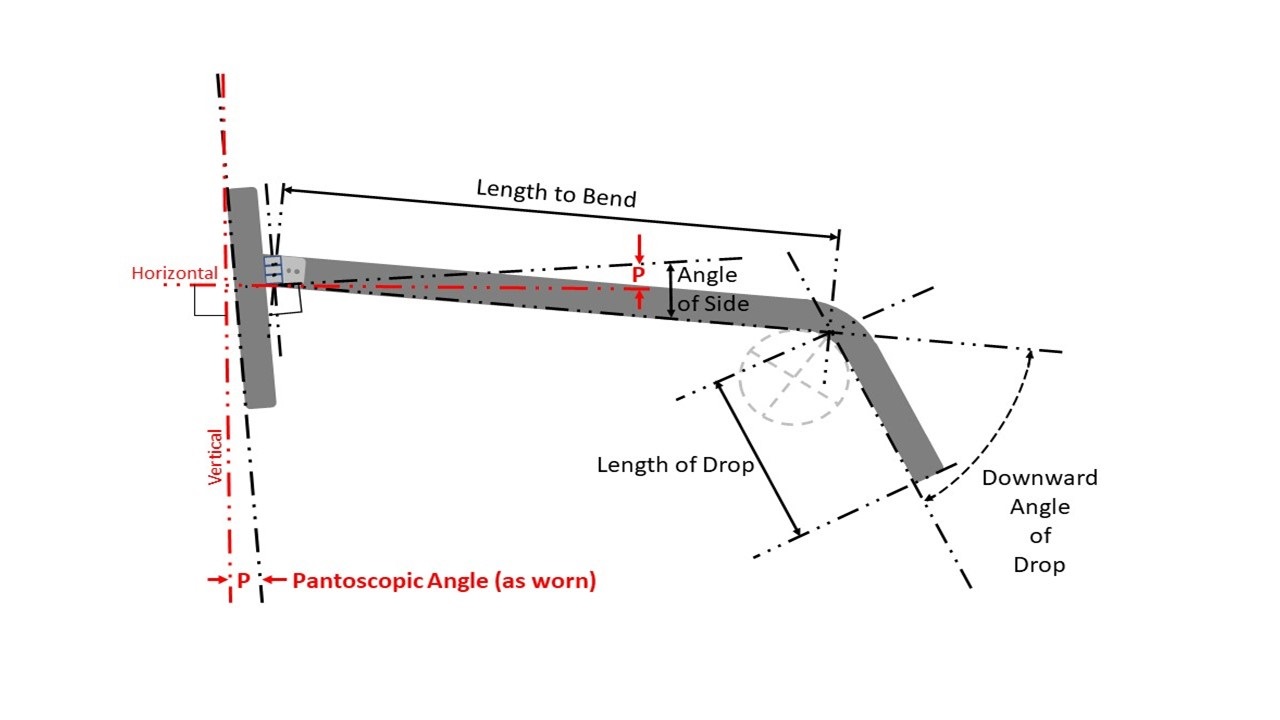 Figure 3: Pantoscopic tilt
Figure 3: Pantoscopic tilt
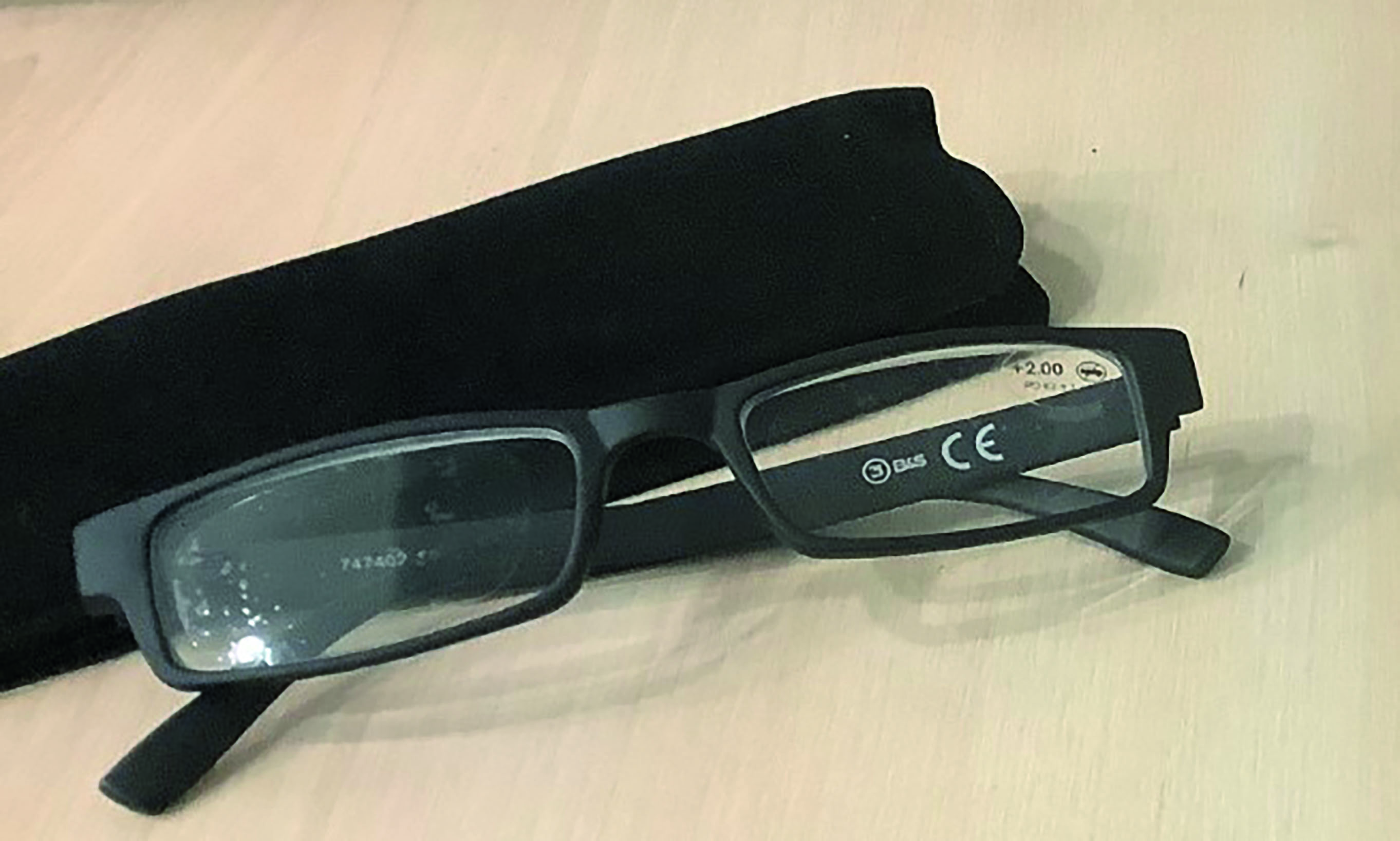 Figure 4: Half-eye spectacles
Figure 4: Half-eye spectacles
As an aside, the common practice of centring high index, aspheric and high-powered lenses on pupil centre is usually incorrect and we do our patients a great disservice by doing so. It is essential to take pantoscopic tilt into account, especially on aspheric lenses, in order for aberrations to be minimised and optimum vision achieved. Based on the typical pantoscopic tilt of most frames being between 7 and 12 degrees and averaging around 10 degrees, the optimum position for vertical optical centres is around 5 below pupil centre, which will often correspond, given current fashions and frame-styling techniques, to the default position of glazing on HCL. In the authors’ experiences, practices that slavishly measure heights without also measuring tilt are seen to have much higher non-tolerance, remake and refund rates than practices that do not bother with heights for single vision glasses, though neither produces results that are as satisfactory as doing the job properly in the first place. These errors are so commonplace that registrants who work with non-qualified dispensing staff are advised to check operating procedures and where pantoscopic tilt gauges are not available provide them.
Bifocal Lenses
The inconvenience, in many situations, of switching between distance, intermediate and near spectacles, led to the invention of bifocals, which provide the patient with a single lens that has two separate focuses enabling presbyopic eyes to see two specific distances clearly.
The distance portion or main lens is almost always the larger of the two areas and corrects either distance or intermediate vision, the area used for reading or closer work is the reading or near portion. Bifocal lens designs offer visual areas free from the aberrational astigmatism present in progressive power lens designs and the convenience of a single pair of spectacles whether for general or task specific wear.
Bifocal manufacturing methods
Bifocals are classified according to method of manufacture including split, solid, fused and cemented segments. Benjamin Franklin is the most recognisable name accredited with the invention of the bifocal lens although Sir Joshua Reynolds and Benjamin West appear to have also played a part in the origins of this lens.2
Split or Franklin split bifocals were the first bifocals to be invented and consist of two separate single vision lenses, one creating the distance the other the reading portion (figure 5). This design is most easily glazed into metal frames although it is possible to glaze to plastic frames. However, the two lenses must be bonded together prior to glazing and the process of springing-in, and especially of removing the lenses from a plastic frame, is prone to cause the lenses to come apart. Split bifocals give a wide distance and reading area. However, the dividing line is very noticeable. Being individual lenses means optical centre positioning, prismatic effects and even prescription can be controlled independently of each other. Consequently, split bifocals still have a place in the dispensing practitioner’s armoury for patients with differing cylinder powers, axes or prisms between distance and near portions of the lens.
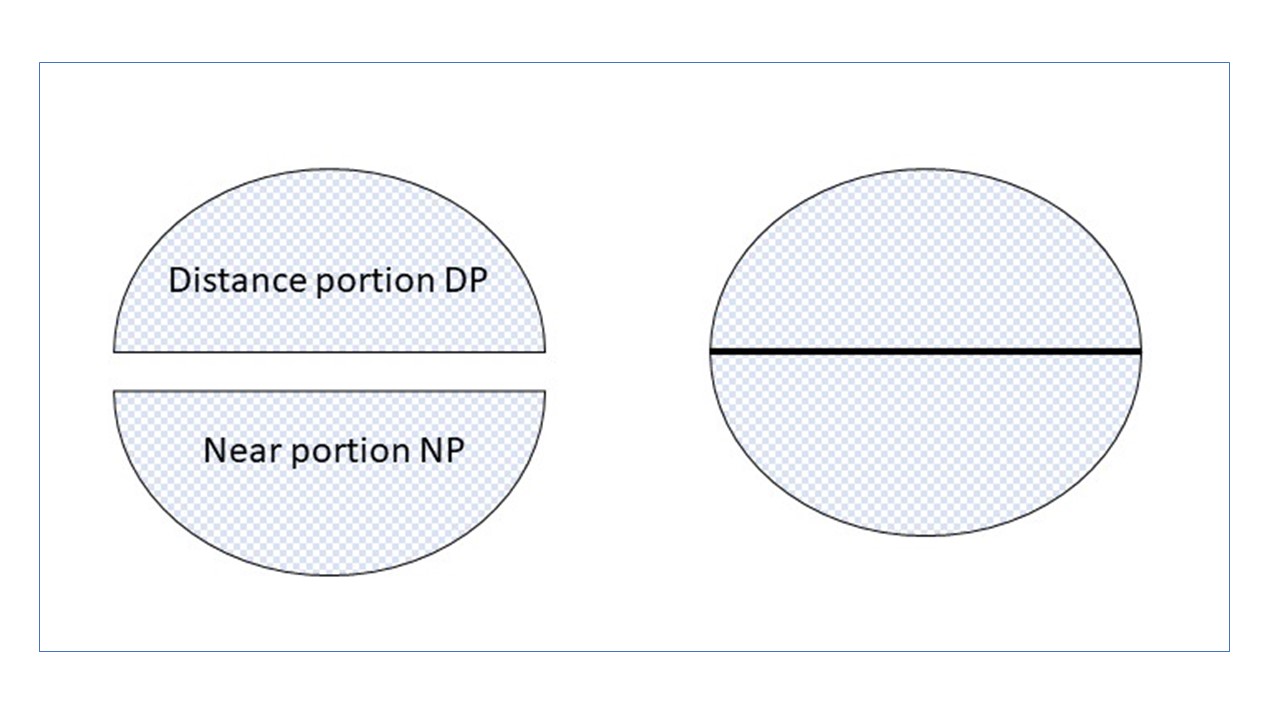 Figure 5: The split bifocal
Figure 5: The split bifocal
Presto bifocals (figure 6) are a modern replacement for the Franklin split bifocal. A single vision base lens is made to the patient’s distance prescription and a hole is created that will accommodate the reading segment. A small second single vision lens is digitally surfaced and shaped to match the hole and inserted into the distance lens to form the reading segment. Like a split bifocal, the Presto lens can accommodate different prism between distance and near as well as differing cylinder powers and/or axis directions. The use of a small diameter segment (typically D28) means it is often possible to accommodate much greater levels of prismatic correction than a split bifocal.
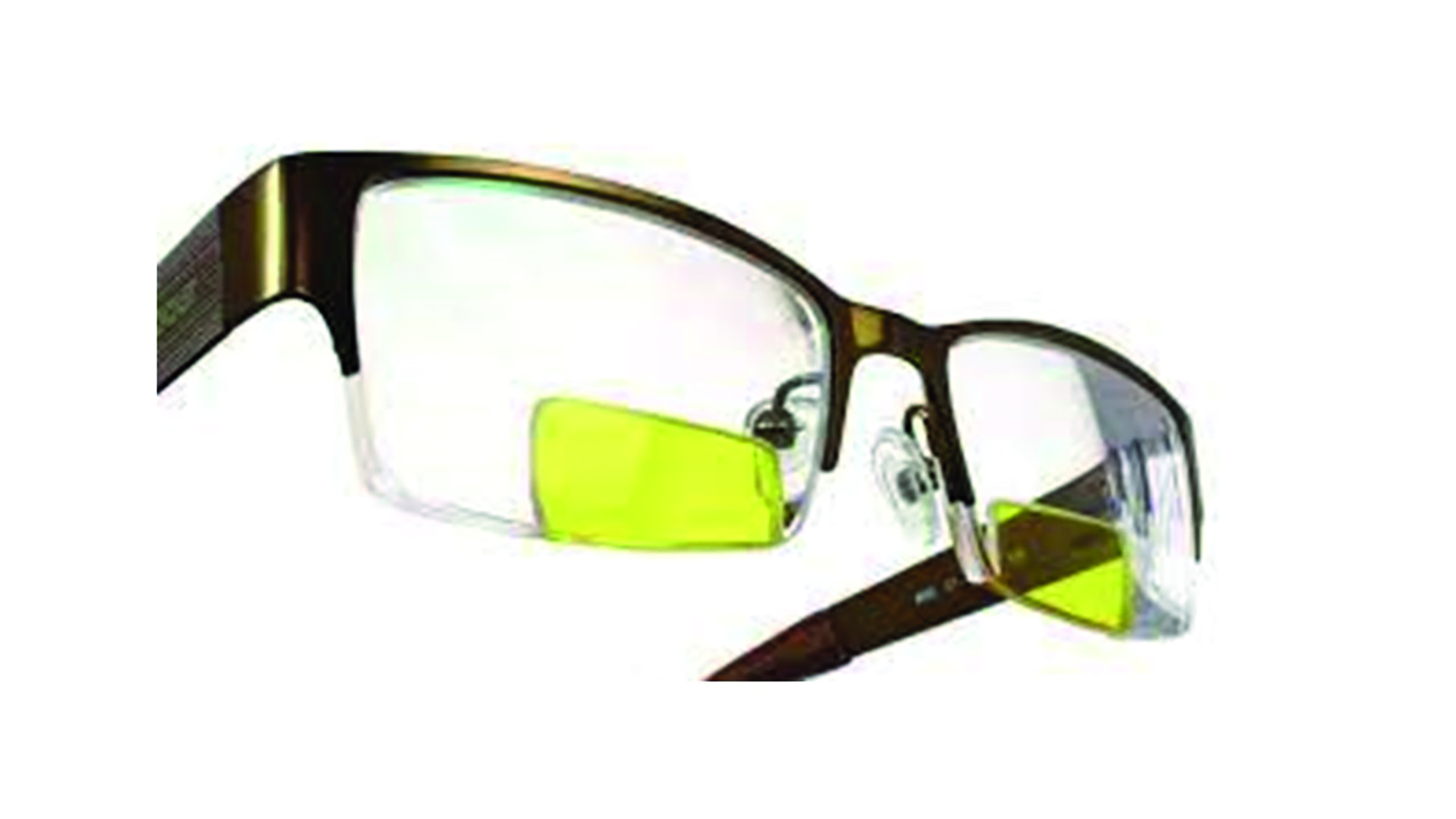 Figure 6: A Presto lens (image courtesy Norville – segments are tinted for clearer illustration)
Figure 6: A Presto lens (image courtesy Norville – segments are tinted for clearer illustration)
Cemented bifocals are manufactured by bonding a glass segment using Canada balsam to a single vision glass lens and similarly enable different amounts of prism and astigmatism to be catered for. In the author’s experience cement segments can also be combined with other methods such as fused, where for example additional prismatic effect is required above what is possible with the base lens. The need for this type of lens has been rendered virtually redundant by the advent of lighter weight alternatives such as Presto and extra inset solid bifocals made in plastic materials.
Stick-on segments, made from flexible silicone-based plastic, are a temporary and (relatively) inexpensive version of the cemented segment. In professional practice, especially hospital eye departments, these are most often used as Fresnel prisms to accommodate very large amounts of prism at near. Sometimes. this is used as a temporary trial measure before more permanent prismatic correction is incorporated.
Stick-on segments, including D28 and D35, are also available and are sometimes supplied direct to the consumer, as spherical additions that can be used to convert distance spectacles or plano sunglasses into effective bifocal correction. Both these and Fresnel foils utilise surface tension and do not require additional adhesive. They are applied using water and can be easily removed and repositioned, and also trimmed to shape if necessary.
Fused bifocals are glass lenses where the reading addition is created by inserting a glass button of a higher refractive index to the base lens and then surfacing the combination so the distance lens and near segment have the same curvature. This means there is no ridge on the lens. The additional power comes from the contact curve between the back of the segment and the base lens, and the fact that the front curve will contribute a greater plus power than the main lens of lower refractive index. The downside of fused bifocals is that, although there is no ledge on straight or curved top bifocals, the segment (including round segments) is still obvious in other ways. The higher refractive index of the segment means colour fringing can be a problem when viewing high contrast near objects, such as well illuminated black print on a white background, due to the increased chromatic aberration. This is especially the case with higher adds that require higher index segments, which inevitably have a lower Abbe value. Another cosmetic problem is that, due to the difference in refractive index when an antireflection coating is applied to the lens, the residual bloom (the colour and amount of light reflected) is different and makes the segment more obvious compared to the main lens.
Solid bifocals are made from one piece of material therefore do not suffer from additional chromatic aberration. To create the additional positive power required for the near portion a different curvature is worked on one surface producing a reading segment. The edge of the segment can be felt, although it is less obvious in round segments than in curved top, straight top, or executive
bifocals.
Glass solid bifocals are increasingly difficult to source, but were manufactured by grinding (surfacing) the segment into the lens blank meaning that only round segments and executive bifocals were available. Glass solid bifocals are very rarely used these days and lens blank production in most cases finished many years ago. This means, as the dwindling stocks of semi-finished lenses are used, these products are inevitably discontinued. In recent years, we have seen the demise of the Round 45 Solid bifocal in crown glass and the Executive bifocal in glass photochromic materials and doubtless many other designs that were common place 25 or 30 years ago.
All plastic bifocals are solid (figure 7) and historically have been produced by casting the plastic monomer with round or shaped segments to form semi-finished lens blanks. Round segments: R22, R24/25, R28, R38, R40; Curved top D segments C25, C28, C40; Straight top D segments S25, S28, S35, S45 and also E-line (executive) bifocals are all available at the time of writing.
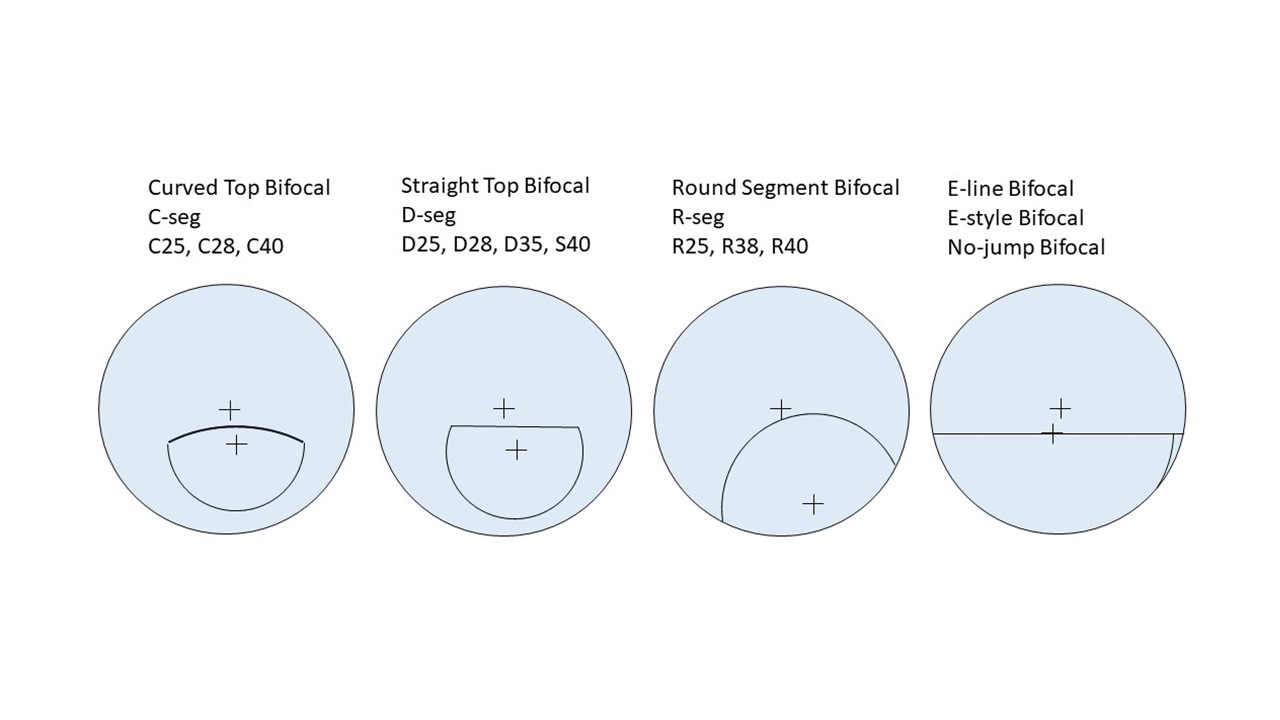 Figure 7: Solid plastic bifocal designs
Figure 7: Solid plastic bifocal designs
Increasingly, free-form technology is employed to surface bifocals from standard single vision lens pucks. Digitally produced segments do not have sharply defined lines but are blended to produce ‘invisible’ bifocals in a variety of round segments from 24 to 110mm, and unlike conventional segments, which are always on the front, may be on the front or back surface of the lens. The same freeform technology can be used on the opposite surface of the lens to the segment to slab off the bottom half of a bifocal (and also trifocal, progressive or single vision lenses) to counteract differential prismatic effect at near.
Bifocal terminology
Some key terms relating to bifocal lenses, listed in BS EN ISO 13666:2019 Ophthalmic optics – Spectacle lenses – Vocabulary, section 3.15, are shown in figures 8 and 9 and defined and explained below:
Segment height: the vertical distance from the segment top to the lowest tangent to the bottom of the lens – either uncut or cut lens.
Segment top position: the vertical distance from the horizontal centre line to the segment top. This measurement applies to the cut lens/frame and is determined by subtracting the lens B measurement (vertical box height) from the segment height.
Segment drop (vertical segment displacement): vertical distance between the distance optical centre and the segment top.
Geometrical inset: the horizontal displacement of the segment centre from the distance optical centre of the main lens (or distance centration pooint in the event there is prescribed prism).
Segment diameter/segment width: for segments where the dividing line is circular, the diameter of the circle of which the boundary of the finished segment forms a part.
Segment geometric centre: centre of the rectangle formed by the horizontal and vertical tangents to the segment’s dividing line, or lens periphery if the segment extends to the lens edge.
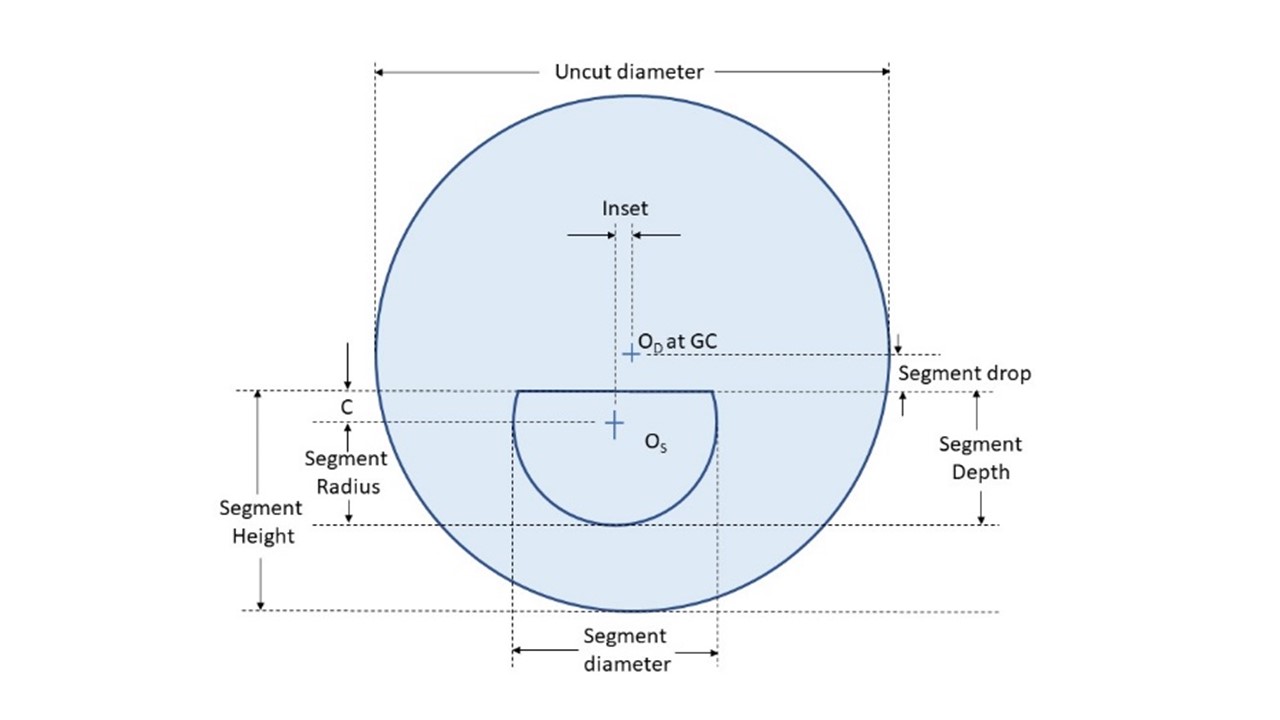 Figure 8: Terms relating to bifocal lenses.
Figure 8: Terms relating to bifocal lenses.
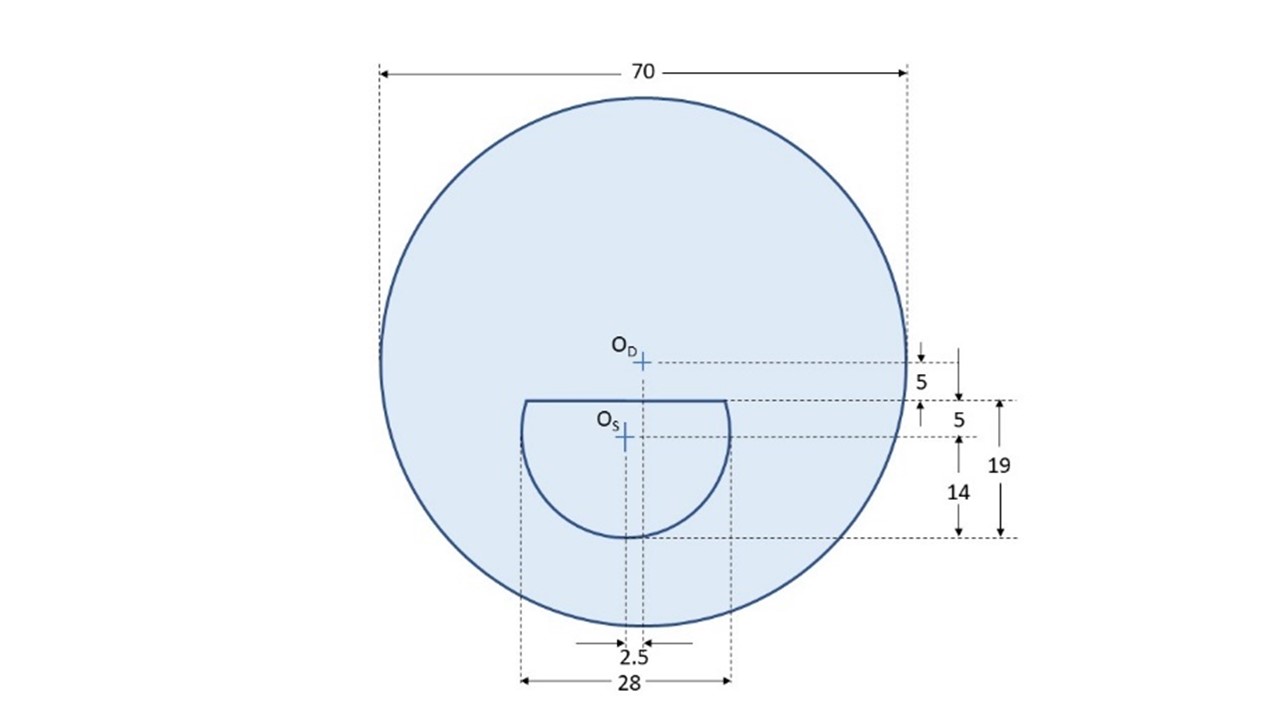 Figure 9: Dimensions relating to a CR39 D28 Bifocal
Figure 9: Dimensions relating to a CR39 D28 Bifocal
Bifocals are available in the usual array of uncut lens diameters 65, 70 and 75mm with smaller diameters available in plus powers if minimum size uncut is specified. Some bifocals, notably E-Line, come in non-standard diameters including 68, 71, 72 and 76mm depending on manufacturer. Most often the distance optical centre, OD, coincides with the geometric centre of the lens, however some lenses are decentred so that the distance optical centre does not coincide with the geometric centre of the uncut lens. Figure 10 shows the dimensions of a Hoya C28 65/70 uncut decentred to fit larger frames.
 Figure 10: A 65/70 decentred C28 bifocal
Figure 10: A 65/70 decentred C28 bifocal
Jump
Jump is defined as a sudden introduction of base down prism at the dividing line and is calculated using Prentice’s Rule, P=cF, where P is the prismatic effect due to jump, c is the distance from the dividing line to the segment optical centre, and F is the addition. As the wearer of a bifocal lens looks from distance to reading, the eye will cross the dividing line of the reading segment at this point and there will be a sudden introduction of base down prism. To the wearer this will appear as if objects jump or move upwards.
Jump is obvious to younger presbyopes when viewing intermediate objects that they can see clearly through both the distance and reading portions of the lens. Imagine a presbyope with a +1.25DS add viewing an object at 80cm through the distance portion of their lens. To see it clearly, they would need to accommodate by +1.25DS and may find this uncomfortable. By tilting the head up slightly, they could just see the object clearly through the near portion of the lens. At the point where the eye crosses the dividing line, the fixated object would appear to ‘jump’ upwards as shown in figure 11, which shows an eye fixating a black letter A through both the distance portion and segment. The rays appear parallel to reflect the fact that they are intersecting each part of the lens infinitesimally close to the dividing line. The ray through the distance portion is barely refracted (appearing to come from the grey letter A), whereas the ray through the top of the segment will be refracted more (appearing to come from the red letter A) with the angle between them representing the image jump.
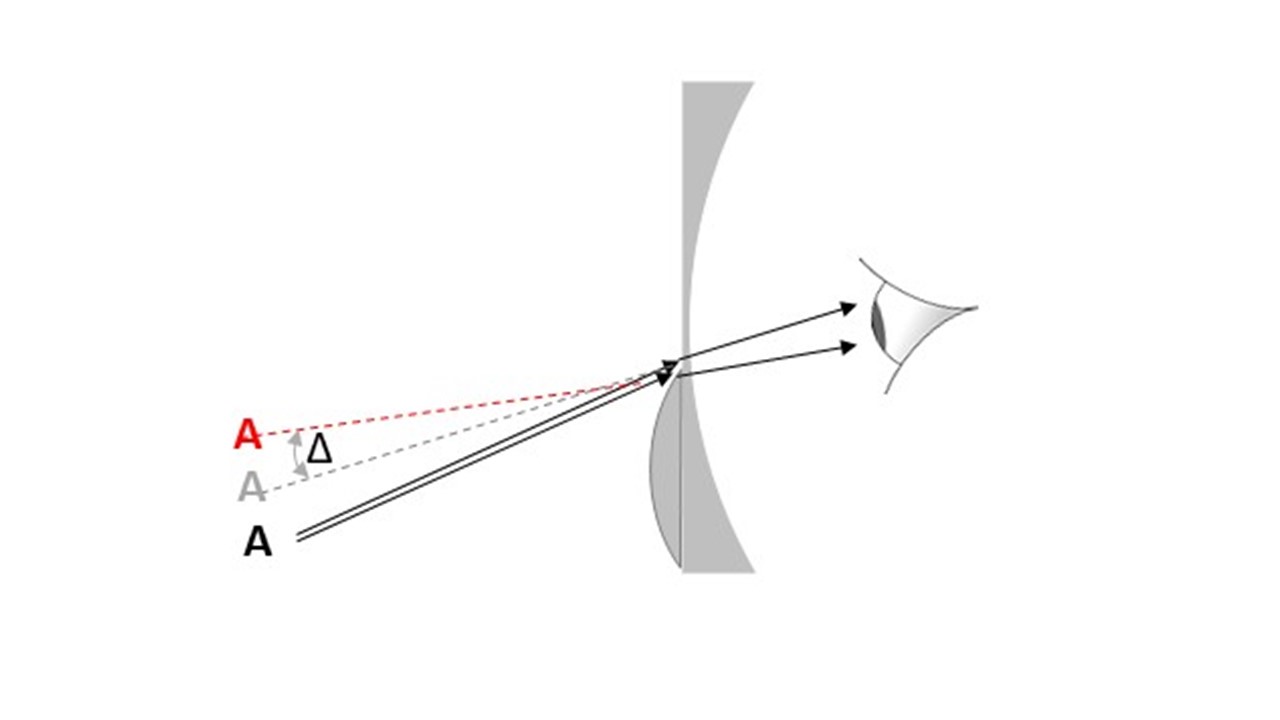 Figure 11: The effect of jump
Figure 11: The effect of jump
Another aspect of jump is shown in figure 12. If the head remains still and views objects in the intermediate range clearly through both portions of the lens, then there is a scotoma or blind spot due to the prismatic effect at the segment top. This can cause particular problems when negotiating stairs as it may cause the bottom stair to disappear and patients should be advised to tuck their chin in to their chest when coming down stairs and use the distance portion of the lens to view the stairs.
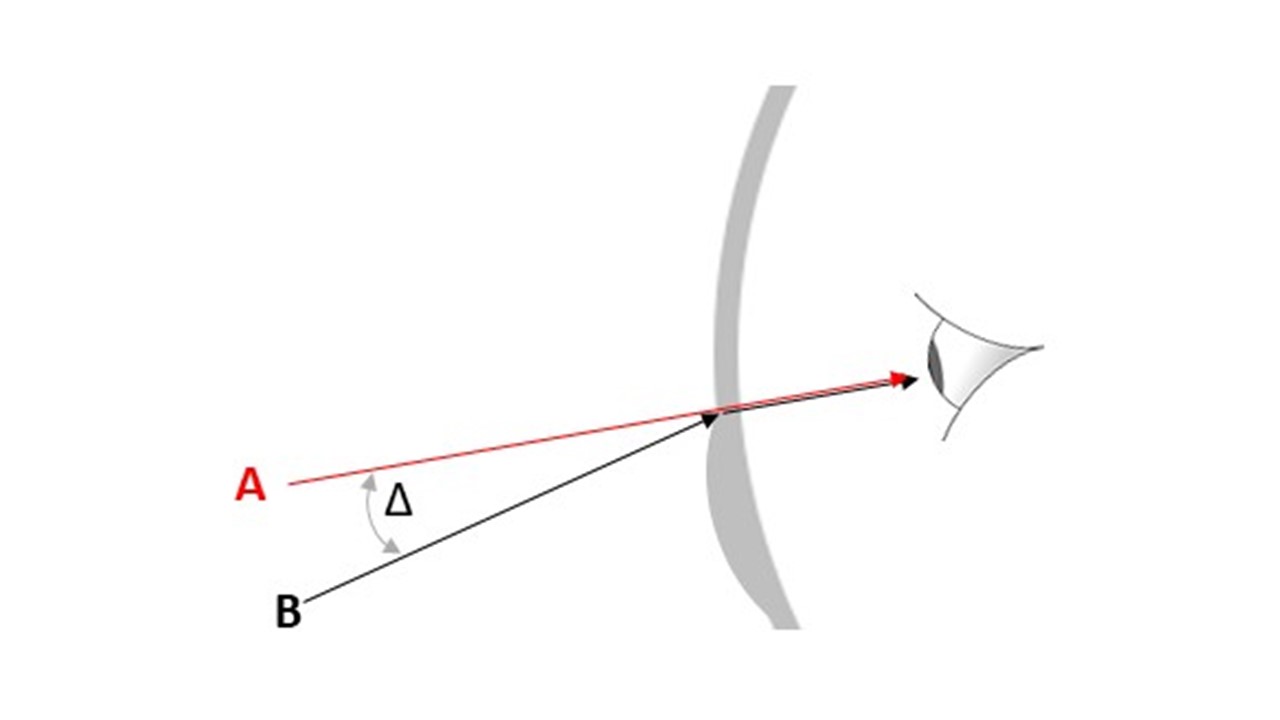 Figure 12: Jump causes a scotoma (blind spot)
Figure 12: Jump causes a scotoma (blind spot)
It can be seen that round segments have a greater jump than D segments as the OS for D segments is usually 4.5 or 5mm below the segment top, whereas in round segments it will be half the radius of the segment.
When the segment optical centre is on the dividing line then there is no jump. The only readily available no-jump bifocal is the E-line bifocal, previously called the Executive bifocal. However, this term is trademarked and no longer a recognised term (figure 13). The other, once commonplace, no-jump bifocal is the D40. However, these are proving increasingly difficult to obtain.
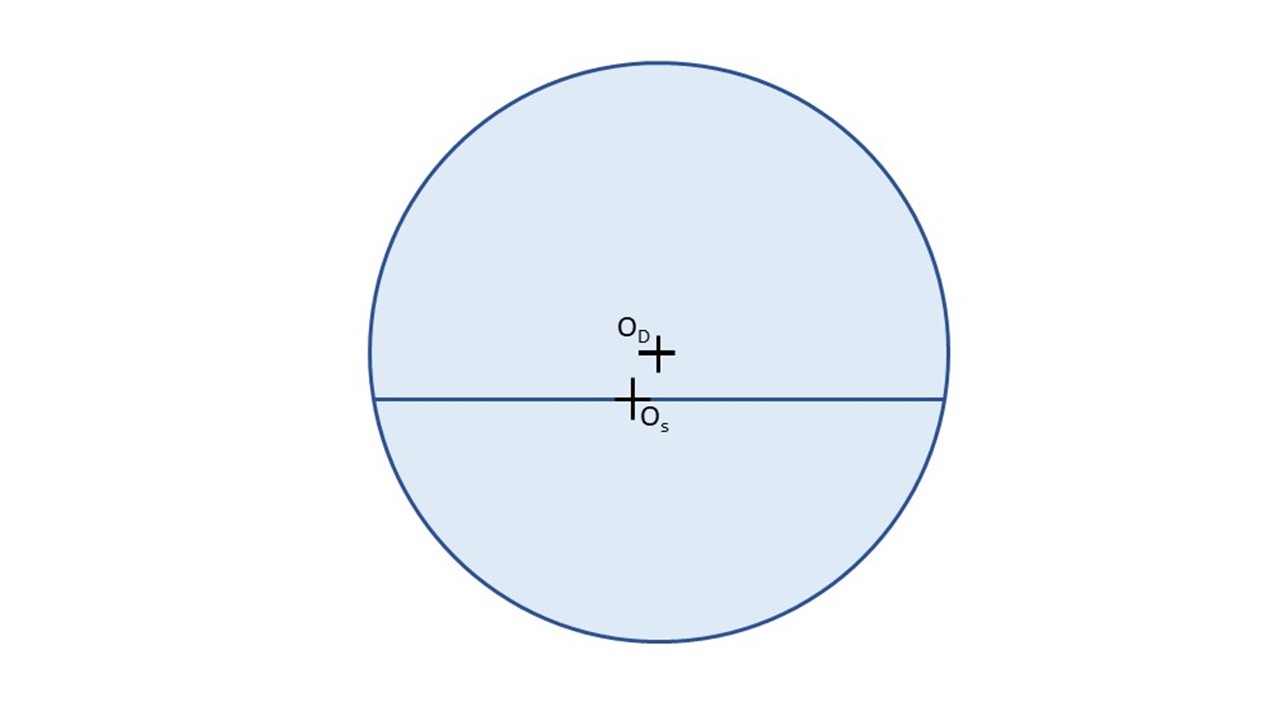 Figure 13: An E-line no-jump bifocal. Note only the segment centre requires to be on the dividing line
Figure 13: An E-line no-jump bifocal. Note only the segment centre requires to be on the dividing line
It should be clear that jump is only dependent on the position of the segment centre and does not depend on the distance optical centre position. While some manufacturers place the distance optical centre of their E-style bifocals on the dividing line this is not required for the lens to be no jump, although it may have other benefits.
It is worth noting that there is no specific term relating the distance from the segment top to the optical centre of the segment (labelled C in figure 8), despite its importance in calculating jump. For round segments, this distance is simply the radius of segment (half the diameter) whereas, for C and D segments, it is determined by subtracting half of the segment diameter from the segment depth. Figure 9 shows the actual values of the various terms for a straight top D28 bifocal. It is also worth remembering that, for almost all C and D segments, the distance from the segment top to the segment centre is either 4.5 or 5mm. For example, C/D25 segments are 17 or 17.5mm deep depending on the manufacturer compared to a segment radius of 12.5mm. As such, the jump induced can quickly be estimated as half of the add. The notable exceptions are S40 segments which, being 20mm deep, have the segment centre on the dividing line and are, therefore, like E-line bifocals with no-jump. D45 segments are 24mm deep so the seg centre is just 1.5mm below he seg top, so keeping jump to a minimum.
Near optical centre
Practitioners will doubtless recall tedious calculations carried out during their time as students to determine the position of the near optical centre of a bifocal lens. The near optical centre position is influenced by the distance prescription, the addition, and segment diameter and drop. It can easily, especially with round segments, fall outside of the lens. Its calculation is unimportant. However, it is important to realise that large round segments combined with high minus prescriptions will be literally ‘off the scale’ when attempting to measure the add on a focimeter that does not have a rotary prism compensator built in.
Total prismatic effect
It is important to be able to visualise the total prismatic effect due to the segment and main lens at different point. Figure 14 traces different rays through a round segment bifocal. The top ray passes through the distance optical centre un-deviated, the next ray at the dividing line causes jump as previously noted. With a round segment the top half of the segment causes base down prism, whereas the bottom half of the segment induces base up prismatic effect. A ray through the segment centre will only exhibit deviation due to the prismatic effect resulting from the main lens. With a minus lens as shown, at some point below the segment centre it may be that the base up from the segment entirely neutralises the base down from the main lens, if the main lens is sufficiently weak in power or the round segment sufficiently large.
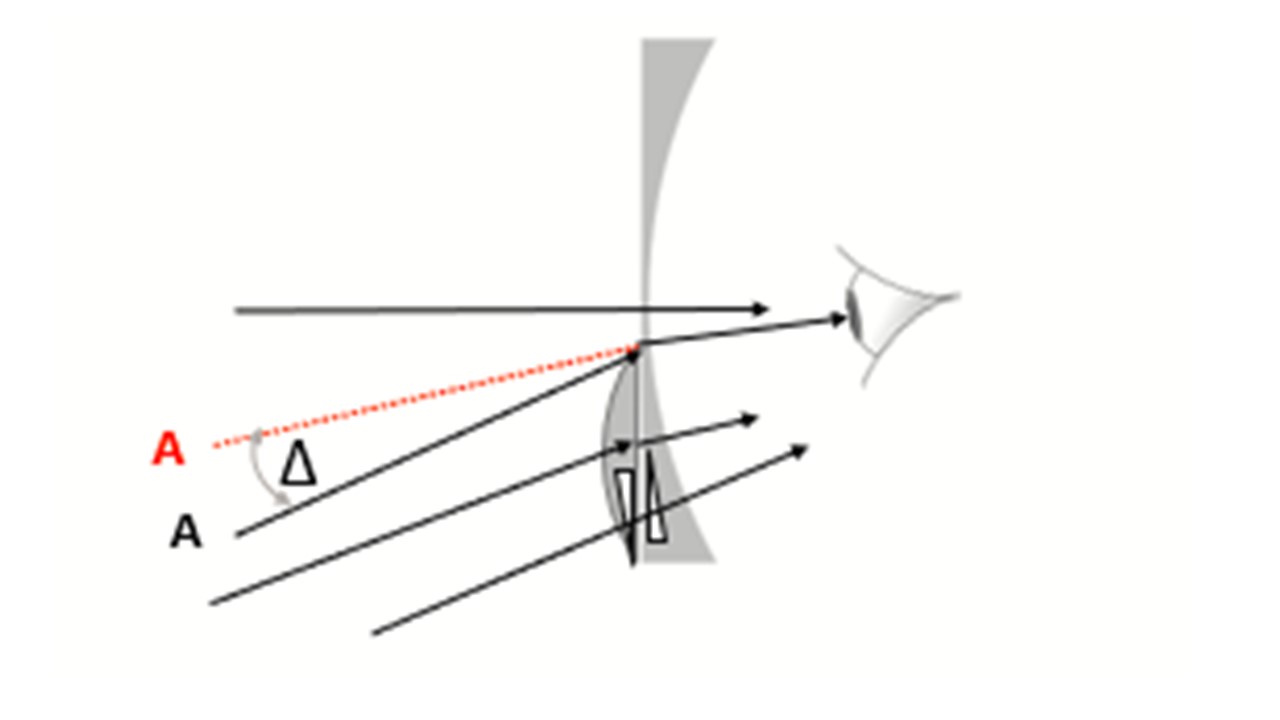 Figure 14: Tracing rays through a bifocal
Figure 14: Tracing rays through a bifocal
Positioning of the bifocal segment
For conventional bifocal fitting, the near segments should ordinarily be located with the segment top at the lower limbus (figure 15) for the wearer to be able to comfortably utilise both the distance and near portions of the lens. While many practitioners use the lower lid position as the segment top reference position it must be remembered that this point in relation to the pupil centre can vary greatly, for example if the patient has ectropion or asymmetric eyelids (figure 16). The lower limbus position is a more consistent marker3 and where it cannot be seen its position needs to be estimated (figure 17).
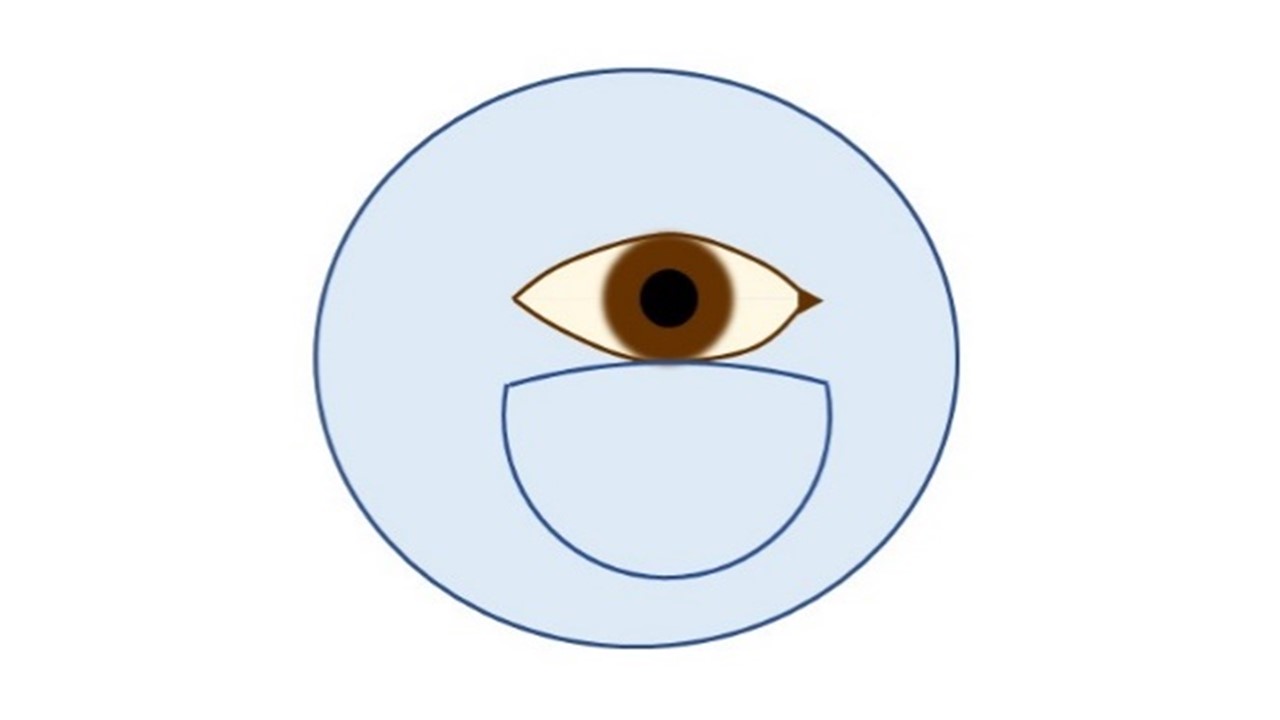 Figure 15: The segment top position should be in line with the lower limbus which may, or may not coincide with the lower lid
Figure 15: The segment top position should be in line with the lower limbus which may, or may not coincide with the lower lid
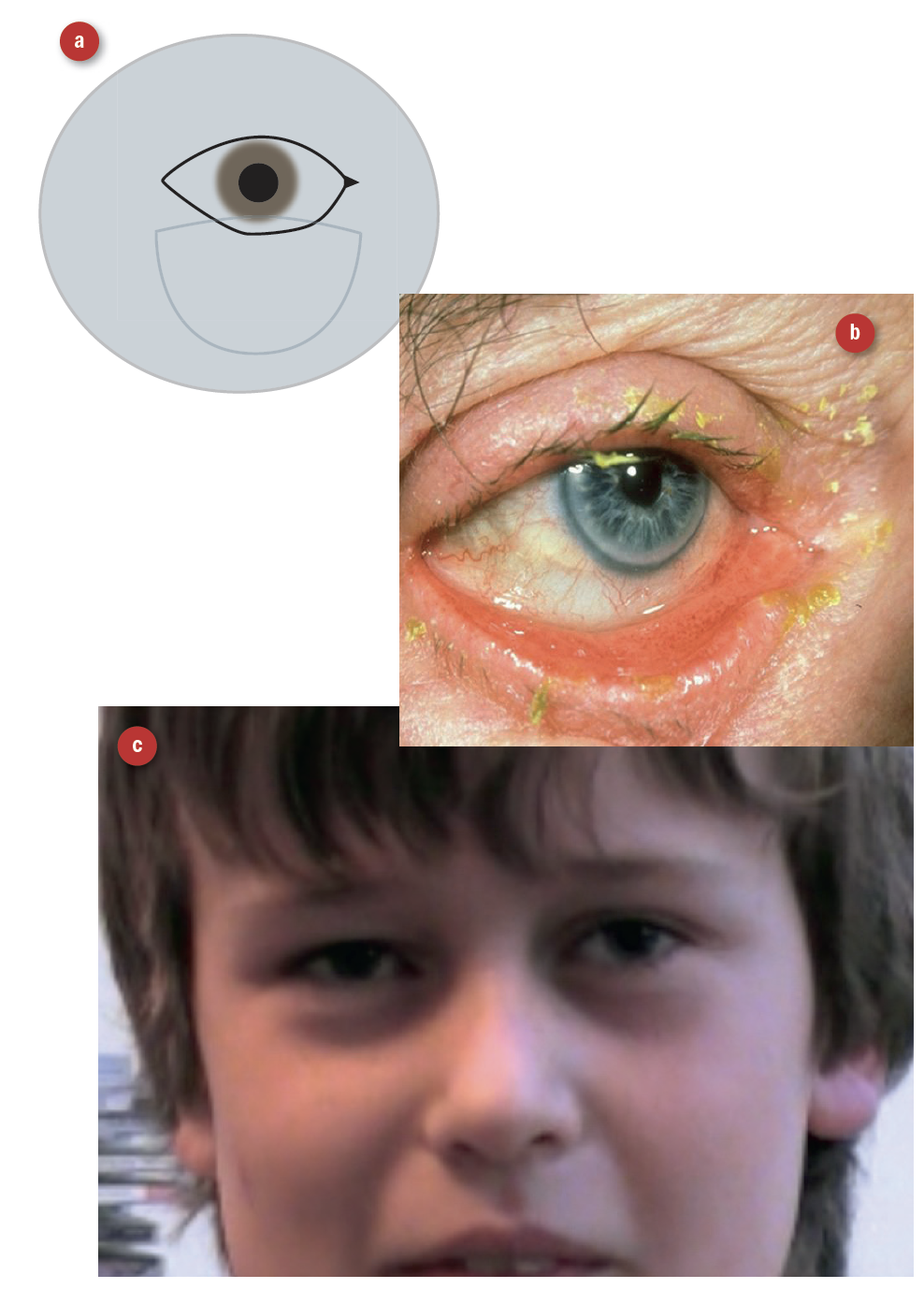 Figure 16: Lower limbus is more reliable as a reference point (a) in the case of (b) ectropion or (c) asymmetric eyelids
Figure 16: Lower limbus is more reliable as a reference point (a) in the case of (b) ectropion or (c) asymmetric eyelids
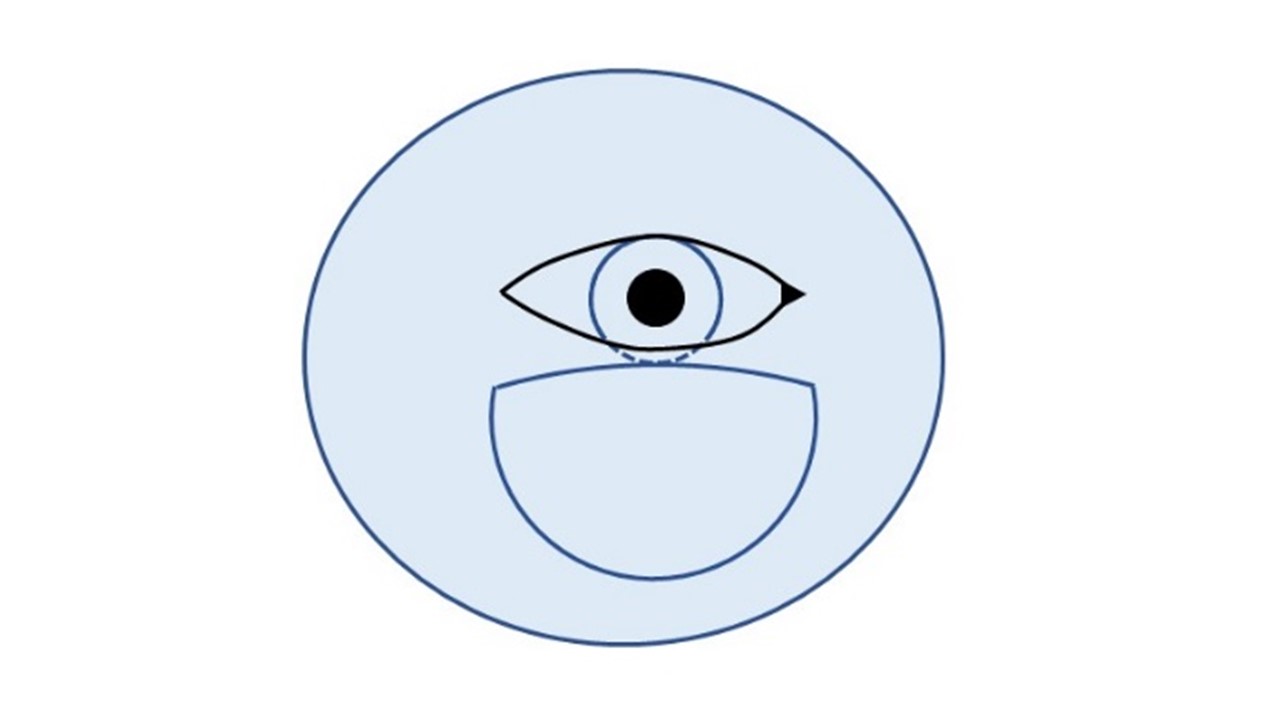 Figure 17: Where the lower limbus is hidden due to a narrow palpebral aperture the position of the lower limbus must be estimated
Figure 17: Where the lower limbus is hidden due to a narrow palpebral aperture the position of the lower limbus must be estimated
The lower limbus is the default position for general wear, however other factors must be taken into account such as the habitual wearing position of any existing bifocals, alongside considerations of intended use. For example, mostly driving with occasional close work may require a slightly lower position compared to predominately near/close work. It is essential to actively listen to the patient and fully consider their visual requirements. Many practitioners fit C and R segments to lower limbus and D/E segments 1 or 2mm lower. The patient must be able to negotiate obstacles like steps and stairs confidently to avoid tripping or a potential fall.
For children with high AC/A (accommodative convergence/accommodation) ratios, and so manifest convergence excess bifocals are often a treatment option. In this situation the segment top should be positioned bisecting the pupil (figure 18) to ensure the child uses the near segment and accommodation is relieved for near. A wide straight top S45 design minimises thickness and weight and provides better cosmesis than an E-line bifocal.
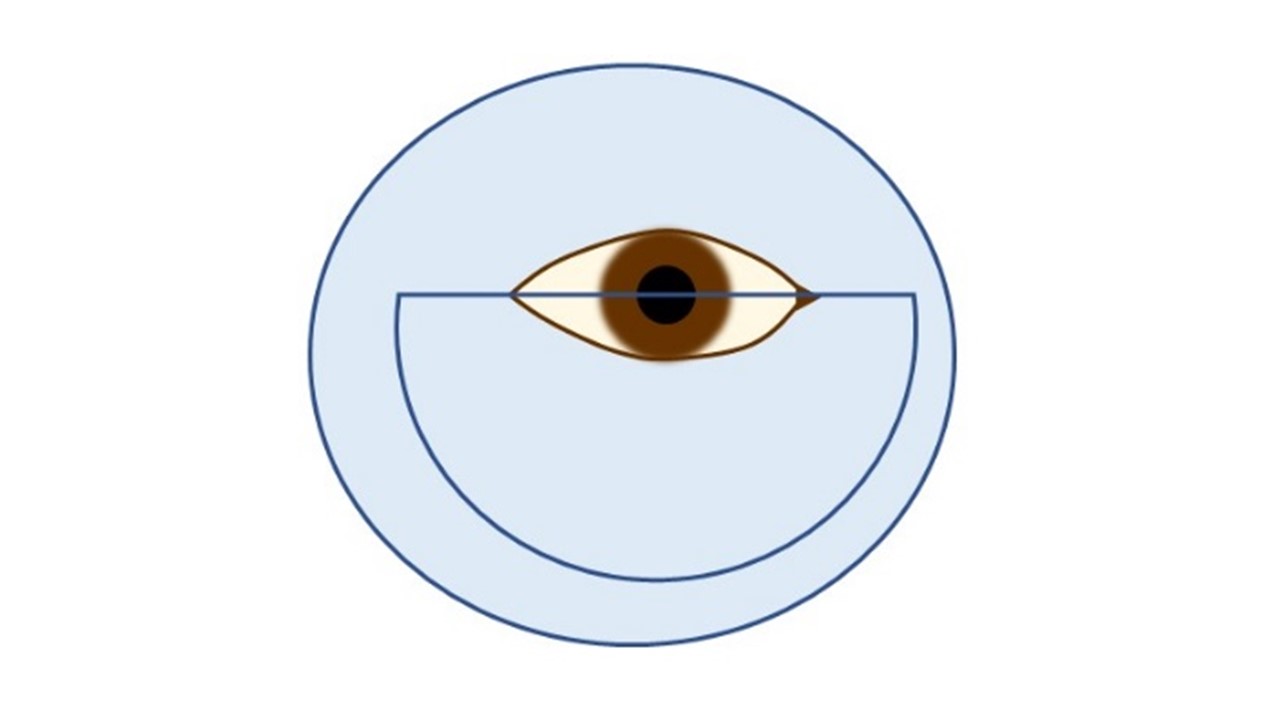
Figure 18: S45 segment bisecting the pupil as useful for managing convergence excess
Selecting segment type and size
Most often, patients requiring bifocals are those that have worn them before and it is obviously prudent to check that they are satisfied with their current bifocal type, size and position. Questions such as ‘have you been happy with your current bifocals?’ are likely to yield an affirmative response but may not identify any room for improvement. Asking if there is anything they feel could be better may identify a need for a wider reading area, elicit any disappointment with the appearance of the segment, highlight any difficulties on steps and kerbs or any number of other issues.
A 28mm curved top or flat top bifocal is a good general-purpose choice for a first-time user with the C28 having the edge in terms of adaptability, cosmesis and jump. Professional drivers may prefer a smaller C25 or D25 seg to facilitate peripheral distance vision when using door mirrors or reversing. C40 and D35/40/45 segments are popular with patients who require a very wide reading area and E-line bifocals should not be dismissed purely on cosmetic/weight grounds since, from an optical standpoint, they are difficult to beat; to the extent that most practitioners will recognise that once patients have worn no-jump bifocals it is difficult to get them to change to alternatives. Round segs have the least noticeable segment to the observer, however jump makes them less user friendly, especially on stairs, and large round segments should be avoided on minus prescriptions for the reasons outlined above.
Problem solving
Bifocal patients may feel the segment is too low or too high for their needs and a frame with adjustable pad on arms can facilitate the raising or lowering of the lenses. Even where there is no adjustment in the bridge the effective height can be altered by adjusting the pantoscopic tilt – increasing it has the effect of lowering the heights and making it flatter has the effect of increasing the heights.
Pantoscopic tilt can itself cause issues with bifocals. Recalling from earlier our discussion of the centre of rotation condition it can be seen that if a D28 segment top aligns with the lower limbus then a patient with an average 11mm diameter iris will have the distance optical centre 0.5mm below pupil centre if the segment drop is 5mm. The distance optical centre should be placed 5mm below pupil if the frame has an average tilt of 10 degrees. With high prescriptions, especially those with significant astigmatism this may cause the patient problems relating to oblique astigmatic error, which will be improved by reducing the pantoscopic tilt or selecting a bifocal with a reduced segment drop. Segment drop can be specified when ordering any bifocal, and certainly if replacing one lens only should be recorded and ordered to match.
Bifocals themselves can be used to solve a variety of problems associated with other forms of lens, most notably differential prismatic effect at near associated with anisometropia, that will be the subject of a future article.
Conclusion
Two separate pairs of distance and reading spectacles, and bifocal lenses still have an important place in ophthalmic dispensing practice especially for Px who are currently wearing them, and those that cannot tolerate progressive power lenses (PPLs). Even the smallest bifocal segments in general use give a wider reading area than any general-purpose progressive lens. Although thanks to improved cosmetic appearance, wider material availability, and the provision of jump-free vision at all distances, progressive lenses have become the default solution to the problem of presbyopia, all opticians must retain a good working knowledge of the alternatives, which can on occasions be advantageous to their patients.
- Peter Black MBA FBDO FEAOO is senior lecturer in ophthalmic dispensing at the University of Central Lancashire, Preston, and is a practical examiner, practice assessor, exam script marker, and past president of the Association of British Dispensing Opticians. Tina Arbon Black BSc (Hons) FBDO CL is director of accredited CET provider Orbita Black Limited, an ABDO practical examiner, practice assessor and exam script marker, and a distance learning tutor for ABDO College
References
- Jalie, M The principles of Ophthalmic Lenses 5th Edn. Kent Association of British Dispensing Opticians 2016. P.78.
- Levene J. Benjamin Franklin, F.R.S., Sir Joshua Reynolds, F.R.S., P.R.A., Benjamin West, P.R.A. and the invention of bifocals. The Royal Society Publishing. 1972. Available from https://royalsocietypublishing.org/doi/abs/10.1098/rsnr.1972.0015 Accessed 1st November 2021.
- Tunnacliffe A. Essentials of Dispensing 3rd Edn. Kent. Association of British Dispensing Opticians. 2007. P.67
